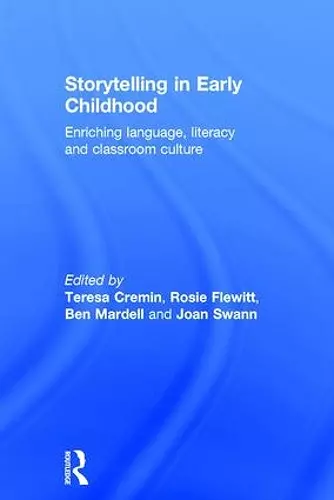Storytelling in Early Childhood
Enriching language, literacy and classroom culture
Joan Swann editor Teresa Cremin editor Ben Mardell editor Rosie Flewitt editor
Format:Hardback
Publisher:Taylor & Francis Ltd
Published:13th Dec '16
Currently unavailable, and unfortunately no date known when it will be back
This hardback is available in another edition too:
- Paperback£41.99(9781138932142)

Storytelling in Early Childhood is a captivating book which explores the multiple dimensions of storytelling and story acting and shows how they enrich language and literacy learning in the early years. Foregrounding the power of children’s own stories in the early and primary years, it provides evidence that storytelling and story acting, a pedagogic approach first developed by Vivian Gussin Paley, affords rich opportunities to foster learning within a play-based and language-rich curriculum. The book explores a number of themes and topics, including:
- the role of imaginary play and its dynamic relationship to narrative;
- how socially situated symbolic actions enrich the emotional, cognitive and social development of children;
- how the interrelated practices of storytelling and dramatisation enhance language and literacy learning, and contribute to an inclusive classroom culture;
- the challenges practitioners face in aligning their understanding of child literacy and learning with a narrow, mandated curriculum which focuses on measurable outcomes.
Driven by an international approach and based on new empirical studies, this volume further advances the field, offering new theoretical and practical analyses of storytelling and story acting from complementary disciplinary perspectives.
This book is a potent and engaging read for anyone intrigued by Paley’s storytelling and story acting curriculum, as well as those practitioners and students with a vested interest in early years literacy and language learning.
With contributions from Vivian Gussin Paley, Patricia ‘Patsy‘ Cooper, Dorothy Faulkner, Natalia Kucirkova, Gillian Dowley McNamee and Ageliki Nicolopoulou.
A much-needed resource for early childhood teachers and literacy educators! Storytelling in Early Childhood: Enriching language, literacy and classroom culture documents the value of play in an era when playtime for superhero stories and sand castles is crumbling under the harsh glare of teacher accountability. Inspired by Vivian Gussin Paley’s groundbreaking work on storytelling and story-acting, this contemporary collection is a refreshing respite and reminder that children still play to learn. Nine leading early childhood scholars provide thoughtful theorization and convincing evidence of the power of children’s play and storytelling and the richness of literacy learning, when their teachers take children seriously, listen deeply, and respond imaginatively.
Karen Wolhend, Indiana University, USA
This book brings together a section of research from different disciplinary perspectives, focusing on the important themes of the role of narrative, story telling and imaginative play in children’s learning. Centred on a timely re-visiting of Vivian Gussin Paley’s work, the authors bring new and contemporary insights into these themes. The book has many features that will engage different audiences.
The chapters report empirical work across international contexts, using a range of theoretical and methodological frameworks. Each chapter contributes to the vibrancy of research that brings together literacy, play, storytelling and drama. What also stands out is the quality of relationships between children and adults – a theme that recurred throughout Paley’s distinguished work. The engagement with inclusion and diversity is embedded throughout the book, reflecting the commitment to democratic classrooms, pedagogies, and relationships.
The interdisciplinary nature of the research projects reported here shows the strength of using different lenses, and what emerges when we think within and beyond disciplinary borders. The authors engage with some well-established theoretical ideas, but from new angles, and with a critical edge that provoke new questions and debates.
This book is multi-vocal and multi-modal in that there are many voices in the chapters – those of the children and the adults who work with them, of professional story actors and storytellers, all with a deep interest in children, and ways of working creatively with them. Inevitably, there is some well-justified critique of current policy frameworks that emphasise an acquisition model of literacy and language, and that ignore the complex social practices that are portrayed so vividly in this book. The authors all respect children’s agency as fundamental to their engagement with complex social practices
The book offers theoretical, empirical and practical insights, and outlines new provocations for future research in this field. I recommend this as essential reading for students, researchers and practitioners in early childhood education, childhood studies, language and literacy studies, and playwork.
Elizabeth Wood, University of Sheffield, UK
Motivated by the work of Vivian Gussin Paley, this volume has a triple focus – children’s own stories, acting them out, and all in the context of playful learning. While we rush children forward, we take the joy out of literacy; this book argues for a vibrant approach that is child-initiated, shared, and highly collaborative. Collateral benefits such as perspective-taking and executive function skills associated with storytelling and acting abound.
Roberta Michnick Golinkoff, University of Delaware, USA
ISBN: 9781138932135
Dimensions: unknown
Weight: 458g
210 pages